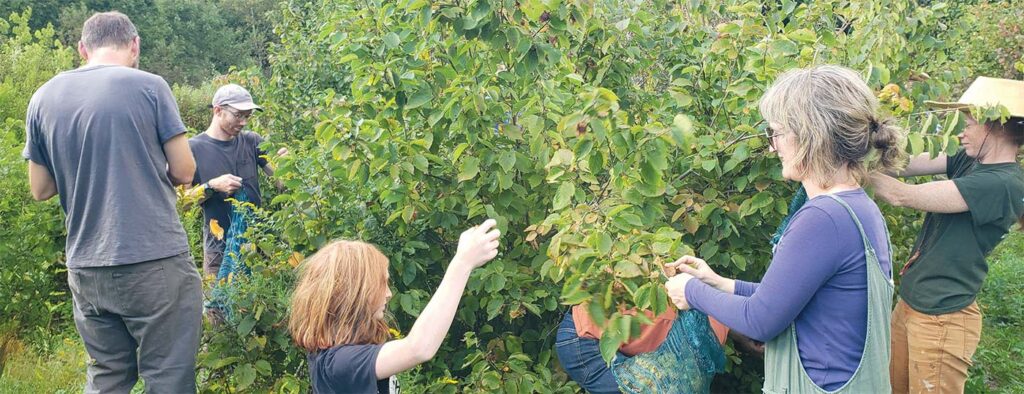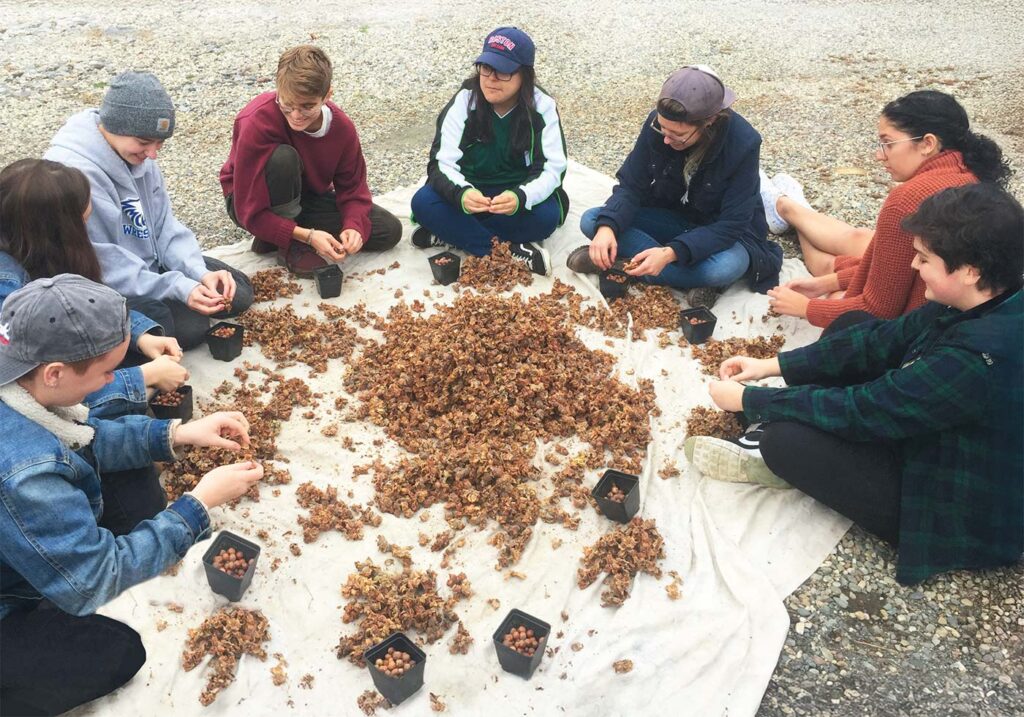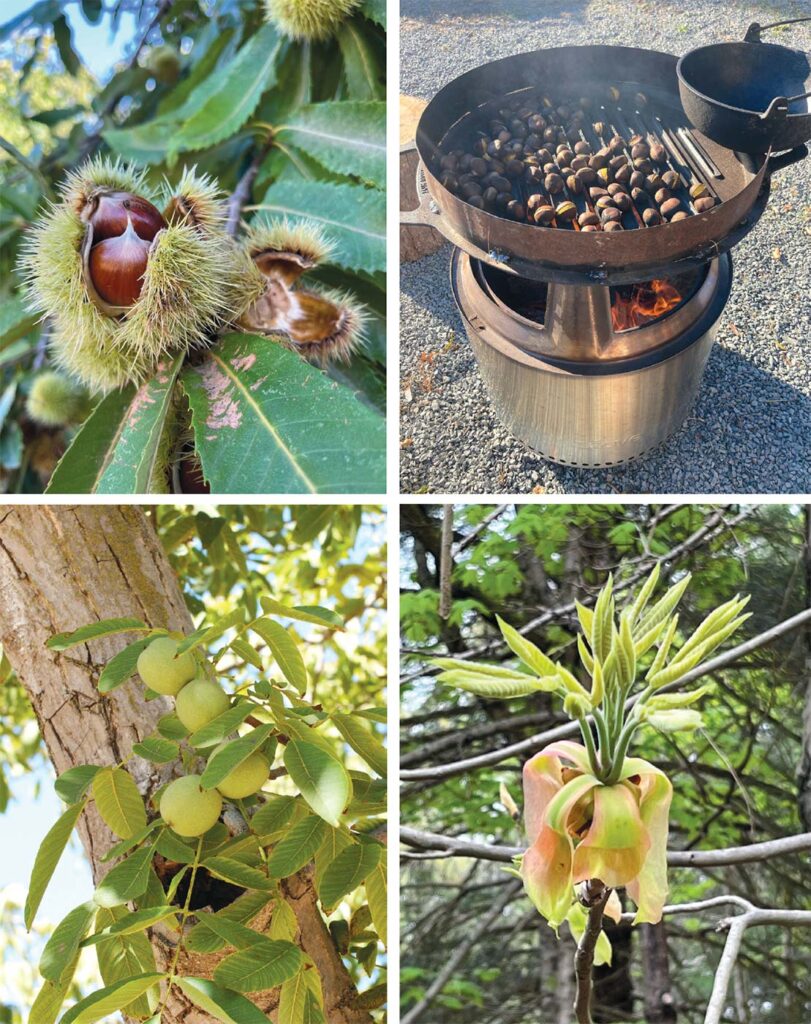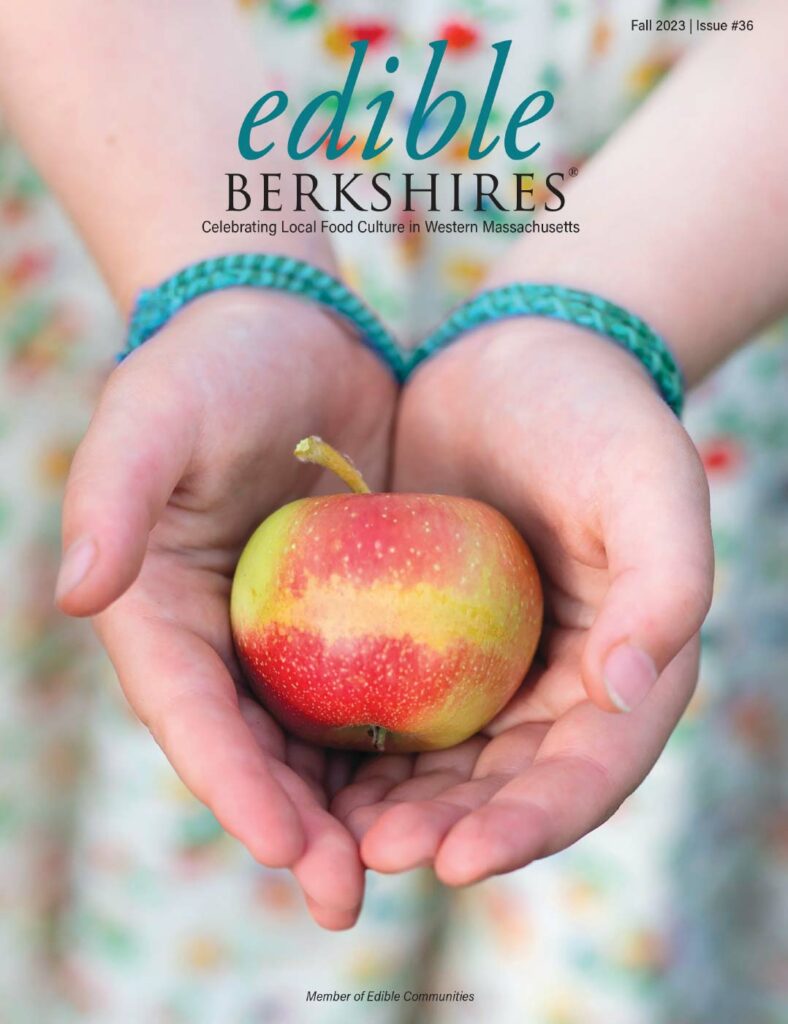
It was a mast year, two autumns into our move to the Berkshires, that brought my attention to the massive shagbark hickory beside our house. Thriving agriculture was one of the strongest draws to making this region home, but my understanding of the crops was somehow narrowed to what I found at the farmers markets. Now and then, a wee basket of chestnuts would appear on a farm stand. But when that single hickory dropped more fruit than the local wildlife could consume or carry off to store for the future, my eyes opened to the presence of nut trees all around me—the food I’d neglected to consider, even though it was literally falling from the trees.
Many of our native nut trees are of outsize importance ecologically. They are critical components of the ecosystem because of what they do. Just a few native plant families support the majority of important food sources on which wildlife’s food chains are built, according to Douglas Tallamy, etymologist-author of Nature’s Best Hope, and one of the foremost proponents of regenerating biodiversity through your home landscape.
Here in the Berkshires, hickories, hazelnuts, walnuts, chestnuts, and oaks are all on that short list. Overlaying that is their potential for climate resilience. “Nut trees are our future,” says Berkshire-based arborist Tom Ingersoll. “Imagine if we cared for them as much as they care for us.”
Perennial nut trees and shrubs are at the heart of many emergent agriculture practices, integral to permaculture, agroforestry, restoration agriculture, and silvopasture (the intentional integration of tree crops, livestock, and forages on the same unit of land). But these food trees are also present all around us in our everyday Berkshire lives—along the country roads we walk, in the hedgerows, in our yards, and in our woods. Many, native to New England, along with feeding wildlife, fed humankind and human culture in this region for thousands of years. They build soil, manage wind, absorb rainwater, pump carbon into the soil, sequestering it long term, and provide a nutrient-dense staple food source. Nut trees once flourished in a relationship with human knowledge and interaction. It’s time to step up and back into this interdependent relationship we’re a part of, and tend the region’s powerhouse nut-bearing trees. Here’s how to
start, right where you are.
OBSERVE AND ASSESS
BECOME A NUT TREE DETECTIVE: What piques your curiosity is your best entry point and lasting compass. I was charmed by the mysterious coronet-shaped pods, bouncing, mobile-like, from a leafy mass of shrubs at the edge of my woods. That attraction was emotional—and motivational. Turns out, I’d discovered a small grove of native Corylus cornuta, “beaked” hazelnuts! Survey your landscape, a nearby wood, a neighbor’s yard, local park or forest, and pay close attention to what draws you in.
LEARN TO LOOK IN ANY SEASON: Tree identification is a year-round affair. Visual keys include leaf types and patterns, twigs, buds, bark, flower, and fruit—that’s a lot of clues! That giant hickory beside my house has a canopy so high I can’t see the leaves from eye level, but its telltale namesake bark is a giveaway. The young shagbark I stare at from my bathroom window has yet to grow that distinguishing curling bark, but in summer, its, gawky, Basset Hound–ear leaves are hard to miss. In spring, shagbark’s dramatic leaf buds are what grab attention, unfurling colorful bud scales that look like large flower petals. Use a field guide as a tool to organize your observations, or join a a local arborist-educator-led Tree ID class, such as the one Tom and Melissa LeVangie Ingersoll have offered through four seasons at the Berkshire Botanical Garden.
You plant hazels and chestnuts for yourself, yellowbuds and black walnuts for your children, and shagbark hickories for your grandkids and theirs.

ENGAGE AND PLAY
Beginner’s mind, meet the Berkshires’ nascent nut farms, where disseminating knowledge through community activities is considered central to renewing a nut culture in the Northeast. Some farms offer a novel, hands-on hit of the nut-tree food system as a whole ecology. Perhaps, one day nut groves could be as culturally familiar destinations for New Englanders as sugar shacks and apple orchards are now.
JOIN A HARVEST WORK PARTY: As soon as I had ID’d hazelnuts growing wild in my landscape, I felt part of something bigger, and I had to find out what. Each fall, hazelnut farmers Seva and Kalyan Water invite folks to help them harvest their crop at Nutwood Farm in Cummington. I jumped at the chance to get in there and find out how it feels to be in a give-and-take with the shrubs. “In some ways, it makes a lot more sense to share knowledge and skills than to trade money for what truly feels like a gift,” says Seva of these work parties. Nutwood grows a European filbert/American hazelnut hybrid that bears easy-to-handle close clusters of multiple nut-bulging husks. Ranging from five to 15 feet tall, their very flexible canes bow, easily accommodating the varying heights of the dozen-plus volunteer pickers the day I was there. At least one picker approached from underneath—parking himself like a piece of furniture, in a butt-to-ground strategy, collecting the ripe nut droppings, scootching from tree to tree.
GRAB A BAG OF JUST-HARVESTED ROASTED CHESTNUTS: Or buy fresh-farmed nuts by the pound to cook with at home. Big River Chestnuts, an agroforestry farm in Sunderland founded by Jono Neiger, has “roasting days” every Saturday from October through early December. Visitors are welcome to tour the farm situated along the Connecticut River to see what a working chestnut orchard looks like, complete with sheep grazing underneath. In an effort to develop a chestnut industry in the Northeast, Neiger has chosen relatively quick-growing, blight-resistant varieties of Chinese chestnuts and Chinese hybrids (many which were created to preserve the American chestnut’s genetics).
Their oldest nut-bearing trees, now seven years old, are yielding roughly 100 pounds of chestnuts per acre, but they are planning (and planting) for closer to 2,000 pounds within 10 years. Earlier this year, Big River Chestnuts received funding through a joint federal and state grant to invest in expanding chestnut processing infrastructure at the farm. The goal over time is to open it up as payfor- use to other nut farmers or create a cooperative farmer-owned processing hub. In past years, the farm has played host to a chestnut festival featuring local nut products, to showcase nut crops’ potential and seed future demand.
COLLECT NUTS FOR A CAUSE: Yellowbud Farm in Northfield is named for Carya cordiformis, a relatively fast-growing native hickory tree, with nuts that yield high-quality, nutritious culinary oil with a 400° smoke point. An agroforestry tree farm and nursery, their vision is for perennial yellowbuds to replace extractive annual row crops and become the source of sustainable cooking oil of the future. Through Northern Forest Foods in Vermont, they’ve begun pressing, and they’ve developed a novel model for collective gathering where folks can forage yellowbud hickories in their environment and contribute their bounty of healthy husked nuts by the gallon via drop-off points in Massachusetts, New Hampshire, and Vermont.

PLANT
You plant hazels and chestnuts for yourself, yellowbuds and black walnuts for your children, and shagbark hickories for your grandkids and theirs.
Most clients of Bridghe McCracken, founder of Helia Native Nursery and Land Design in Great Barrington, are interested in “creating a vibrant ecosystem, with an impulse to create food. The idea of what is food has changed, though, with folks exploring different sources for wild food…pushing in to unusual edibles with a curiosity to explore flavors and protein sources.” Nut trees, she says, “are the overachievers of the native plant world—of the edible plant world,” and once established, she says, nut trees are relatively maintenance free. Hazelnuts will start to flower and fruit by about year five, but in the meantime these dense shrubs are abundant hideout habitat for wildlife. A row of them makes a good windbreak or a “living snow fence” to block drifting snow.
Arthur’s Point Farm in Ghent is a tree nursery (and more) specializing in native and naturalized bare root trees (without soil-ball and burlap around their roots). Bare root trees have the advantage: with over 200% more root mass, they are better equipped for establishment in the soil. And they’re easier to plant (a young tree without soil weighs little), no machinery required. The nursery favors species “with potential to adapt to expected changes in temperature, precipitation, and seasonality in the decades to come,” and uses the U.S. Forest Service Climate Change Tree Atlas to help inform what they plant on their farm and offer for sale. “There’s a dearth of healthy native trees in the nursery space,” says founder David Newman, “It’s a great opportunity.”
One of the best ways to have your nut tree questions answered is to make friends with an arborist and then pick their brain. In addition to selling American hazelnuts, Ward’s Nursery in Great Barrington hosts learning sessions and workshops with Berkshire-based arborists. The tree professionals who lead them consider Q and A’s to be a public service and consumers as their partners in disseminating quality information. When consumers speak of planting for habitat, they mostly conceptualize other creatures. But by planting long-lived nut trees and tending them, they’re fixing human creatures within that ecosystem.

Many of our native nut trees are of outsize importance ecologically. They are critical components of the ecosystem because of what they do. Just a few native plant families support the majority of important food sources on which wildlife’s food chains are built.








